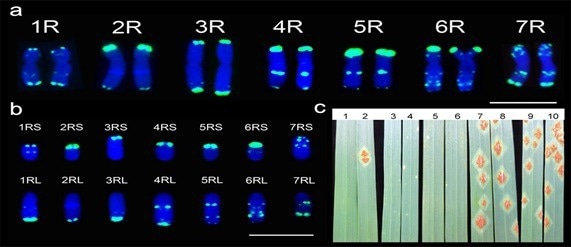Dr Fangpu Han’s team from the Institute of Genetics and Developmental Biology of the Chinese Academy of Sciences has recently reported the development of novel wheat-rye addition lines that imparted resistance to Ug99 in a work that was published online in Theoretical and Applied Genetics.
 The karyotype of wheat-rye addition lines and assessment of resistance to Ug99. Image Credit: Institute of Genetics and Developmental Biology.
The karyotype of wheat-rye addition lines and assessment of resistance to Ug99. Image Credit: Institute of Genetics and Developmental Biology.
Puccinia graminis f. sp. Tritici’s novel strain Ug99 is virulent to many wheat cultivars globally and poses a serious risk to the safety of the world’s food supply. Therefore, it is crucial and urgent to find new sources of resistance genes and introduce them into wheat.
Closely related to wheat, rye is resistant to powdery mildew, leaf rust, stripe rust, and stem rust. For advancements in wheat genetics, it has emerged as a valuable source of a number of broad-spectrum disease resistance genes.
By using molecular cytogenetic techniques, the researchers in this work created two entirely new sets of wheat–rye disomic addition lines. From the offspring of wheat–rye monosomic addition lines, a fresh set of telosomic addition lines was subsequently produced.
Through evaluations of disease resistance, cytological analyses, and genetic markers, they found that the wheat–rye 3RL telosomic addition line had a unique resistance gene to Ug99. Therefore, future wheat breeding can take advantage of the novel Ug99 resistance gene.
Wheat–rye distant hybridization also results in a variety of chromosomal and centromeric alterations. From the offspring of wheat–rye hybrids, this mechanism produces ring chromosomes, dicentric chromosomes, minichromosomes, and tricentric chromosomes.
For research on the structure, activation/inactivation, and function of centromeres, these materials offer invaluable genetic resources. These sources will offer crucial genetic diversity for future wheat–rye hybrid offsprings as well as hints for the identification of additional Ug99 resistance genes that will eventually be inserted into wheat.
Source:
Journal reference:
Liu, C., et al. (2022) Establishment of a set of wheat-rye addition lines with resistance to stem rust. Theoretical and Applied Genetics. doi.org/10.1007/s00122-022-04127-7.